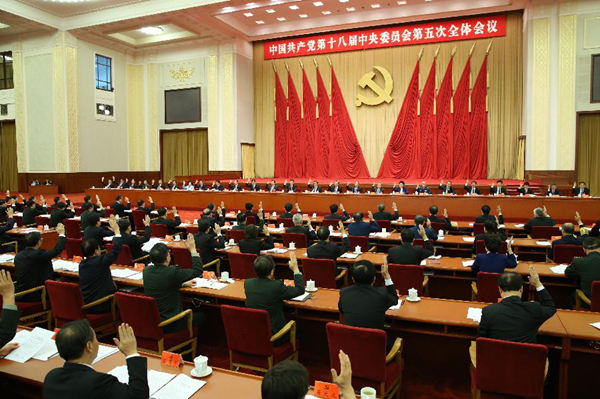China's Five Year Plan to achieve a 'moderately prosperous society'
- By John Ross
 0 Comment(s)
0 Comment(s) Print
Print E-mail China.org.cn, October 30, 2015
E-mail China.org.cn, October 30, 2015
|
The Fifth Plenary Session of the 18th Communist Party of China (CPC) Central Committee is held in Beijing, capital of China, from Oct. 26 to 29, 2015. [Huang Jingwen/Xinhua] |
Western media analysis of the Communist Party of China (CPC) Central Committee Plenum to consider the outlines of the 13th Five Year Plan was dominated by discussion of the possible GDP growth rate to be set, while immediate news reports focused on replacement of the "one child" family planning policy with a "two child" one. Chinese commentary, in contrast, focussed in a more rounded fashion on the plan's goals for living standards together with social and environmental conditions. This was also the main emphasis specified by the CPC's official goal of achieving a "moderately prosperous society in all respects" by the plan's end in 2020.
It is important to understand why China's, not the Western media's, view of the Plan is correct. Analyzing this also simultaneously clarifies some Western economists' error in saying China does not need Five Year Plans and that a target for GDP growth should be abandoned.
The central economic target of the new plan, around which its key parameters are constructed, is China's goal of doubling the income, and therefore potential consumption, of both its urban and rural population in 2010-2020. This requires essentially similar GDP growth.
But achieving a "moderately prosperous society" includes not only a target for income and consumption but also development of education, health, environmental improvement and other strategic factors. Implementation of the 13th Five Year Plan is intended to constitute the first key milestone in China's overall development as reiterated by Xi Jinping: "We have set the goals of completing the building of a moderately prosperous society in all respects by the centenary of the CPC in 2021 and building China into a modern socialist country that is prosperous, strong, democratic, culturally advanced, and harmonious by the centenary of the PRC in 2049 so as to realize the Chinese Dream of the rejuvenation of the Chinese nation."
In this overall framework a GDP growth target is significant - but as a means and not an end. Achieving GDP growth, in conditions in which China's economy is far more developed than previously, does directly determine the Plan's new economic priorities such as advanced manufacturing, innovation, integration of the internet with other economic sectors and use of "Big Data." But economic growth is simply the Plan's indispensable means to achieve broader human and national goals.
To understand this link between economic development and overall social goals, it should be understood that per capita GDP growth is not socially neutral nor primarily desirable because it results in outputs such as steel and cement. The key point is that per capita GDP growth is highly correlated with extremely desirable human goals such as rising life expectancy, increasing consumption, and improving health and education. Therefore only by closing its gap in per capita GDP with the most developed economies can China achieve the best possible all round living standards for its population.







Go to Forum >>0 Comment(s)